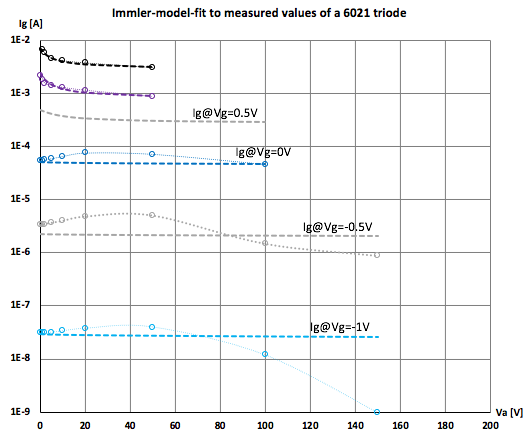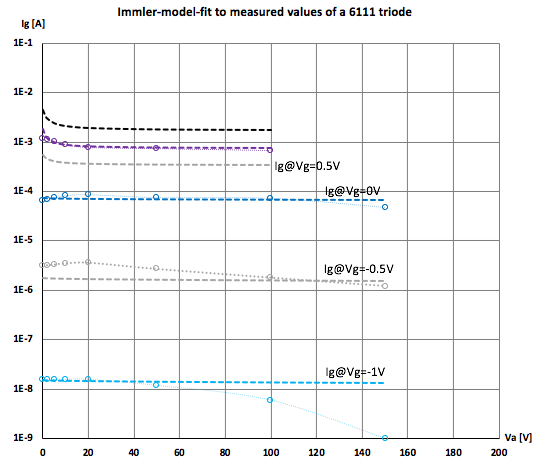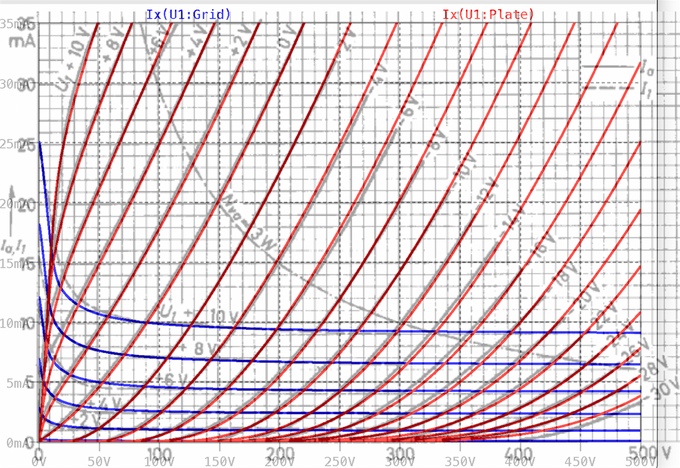Best sample out of 16, selection done after 100h burnin.
12AX7.TSr4 (Tung-Sol twin triode, low noise, low microphonics)
Best sample out of 10 burnt-in triode systems.
Note the re-adjusted gridcurrent model. It is more accurate below approximately 100uA compared to the old 12AX7.TSi4 model. To distinguish the new from the old model without enlarge the suffix, I replaced the "i" by an "r" which means "re-adjusted".
I apologize for the not so well fitted 12AX7.TSi4 model.
2C22 (RCA low mu singe triode, octal base)
6021 (Thomson-CSF Subminiature Twin Triode)
6111 (Philips Subminiature Twin Triode)
6814 (Sylvania Submini Triode, copes long cutoff times)
6922EH (electro-harmonix twin triode with strap grid)
Very linear triode, which has (for this kind of tube) a well suppressed island effect. High gm.
6948 (Sylvania Subminiature Twin Triode)
6AM4 (high mu, high gm VHF triode)
This triode offers both high mu and high gm, with still quite moderate heating requirements. Note that it is designed for grounded grid configuration, so the usage in standard configuration might show a significant high input capasitance.
6BN4A (Sylvania medium mu VHF triode)
For its relatively high mu, the 6BN4A performes amazingly good under low plate voltage conditions.
6FM7#1 (General Electric, section1 triode)
6N1P (Soviet Twin triode, from Voskhod factory)
This Model is based on measurements of the most typical triode out of 10 triode systems, each burnt-in for 100h. It is optimized for any grid voltage up to +4V.
6N2P (Soviet Twin triode, from Voskhod factory)
This Model is based on measurements of the most typical triode out of 10 triode systems, each burnt-in for 100h.
6N3P (soviet Twin Triode, from Vinniza factory)
best sample out of 10 triodes, each burnt-in for 100h.
6N6P (soviet Output Twin Triode, Novosibirsk factory)
This model is based on the most representative triode out of 4 tubes, all burnt-in for 100 hours.
6N14P (twin triode for cascode)
This model is based on the most representative triode out of 5 tubes, all burnt-in for 100 hours. Note that this tube turned out as quite linear (with an exponent of only 1.37) when used below Va=100V.
Diese Seite teilen
link to my older triode spice models
My newer tube spice models are in my tube model repository.
12AT7EHG.i4 (electro-harmonics twin triode, gold pin)
6N15P (Twin triode with common cathode, 7-pin base)
This model is based on the most representative triode out of 5 tubes, all burnt-in for 100 hours.
Note that this tube is very special regarding its manufacturing tolerances: While it is simply the best in terms of contact voltage variations, its plate resistance has a quite high tolerance.
6SN7.RAi4 (Raytheon general purpose twin triode)
This model is quite accurate up to Vg=4V and offers usable accuracy up to Vg=16V.
7963 (Sylvania Submini Twin Triode, strap grid)
811A (RCA power triode, direct heated)
8808 (RCA Nuvistor triode, high gm, ultra low noise, copes GHz, class C capable)
A2293 (G.E.C. 15W power triode)
This model is based on the most representative triode out of 5 samples, burnt-in for 100h.
E82CC (Philips long plate low mu triode)
This triode has the same long plate construction as the NOS Telefunken ECC82 (plate length is approx. 15mm), and seems to be of quite similar construction like the JJ ECC802S.
ECC81 (Philips Twin Triode)
ECC81.RFi4 (RFT Twin Triode)
Best sample out of 16, selection done after 100h burnin.
ECC86 (Zaerix Low Voltage Twin Triode)
LV13 (Telefunken power triode, class C capable)
PC900 (high mu, semi remote cutoff triode)
This model is based on the most representive sample out of 5 tubes, each burntin for 100h. So far, all electrode constructions I have seen were identical regardless of the brand. So, the suffix is shortened as the both letters for the manufacturer is not needed for this tube.
Note that this tube shows gm drift (about +10%) when the anode runs hot. For bias points with anode losses above 1W, it is better to use my PC900.i6 model (based on "hot plate" measurements)
PC97 (high slope triode with frame grid)
It is a Valvo tube. The Siemens verson is totally identical, while the Telefunken showes higher gm and contact voltage. Best sample out of 6 burnt-in triodes.



























































